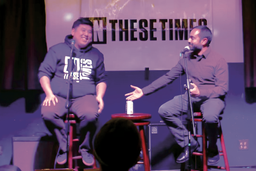Television broadcasters in the Aloha State have been quietly embarking on an underhanded media merger for more than a year.
In August, the CBS, NBC and MyNetwork affiliates in Honolulu announced that they were folding into one of the “largest television news operations” in Hawaii, combining the stations’ staff and newsrooms. The three news stations will now be housed in the same place, sharing reporters and editorial ideas, but they will broadcast from separate channels, appearing as distinct entities to viewers. Nearly 70 employees from the stations will lose their jobs.
The consolidated operation will be controlled by one company: Raycom Media. Raycom is among the nation’s largest broadcasters, with 46 television stations in 36 markets and 18 states. The company has been careful not to call the deal “media consolidation,” instead referring to it as an innocuous “Shared Services Agreement.” Raycom says the arrangement will save struggling news stations.
But one public interest organization in Hawaii isn’t buying Raycom’s PR spin. In September, the nonprofit group Media Council Hawaii, represented by Georgetown University’s Institute for Public Representation, filed an official complaint (PDF link) with the Federal Communications Commission. The complaint alleges that because Raycom will effectively control the local news programming, personnel and finances of all three stations, the agreement is actually an illegal license transfer that violates FCC local television ownership rules.
The FCC followed up on the complaint earlier this month by requesting additional information about the agreements from the broadcast stations and Raycom. In response, Media Council Hawaii reiterated its concerns: “If the Commission does not act promptly to stop this…run around its ownership limits, stations all over the country that are experiencing financial difficulties will enter into similar arrangements.”
Bypassing federal law
The FCC’s longstanding local television ownership rules prohibit an entity from controlling two top-four stations or more than two stations in the same area. The rules exist for a reason: to protect competition and viewpoint diversity in local communities.
It’s important that TV stations keep their news operations separate to ensure that viewers get varying information and viewpoints. We want media to compete for our eyeballs by serving up quality reporting.
Already, media consolidation has led to disastrous results for news in communities. As more and more absentee corporations have gobbled up TV stations in the pursuit of profit, local news has become increasingly cookie-cutter. News segments focus on cheap and easily produced programming. If we’ve learned anything from media consolidation to date, it’s that it degrades investigative journalism and quality reporting.
Raycom argues that its local news sharing doesn’t violate ownership rules because there was no “official” transfer of licenses. “We do not need any regulatory approvals,” Paul McTear, the company’s CEO, told KITV.com.
In reality, Raycom will control three stations serving Honolulu, two of which are among the capital’s top four stations. Hawaiians will get fewer reporters on the beat, with one company deciding what gets on the air.
“Better coverage” for communities, as Raycom suggests? Hardly. Sounds like covert consolidation to me.
‘Inroads’ into quality coverage
Local news sharing agreements aren’t just cropping up in Hawaii. In an attempt to cut costs, dozens of broadcast stations are now pooling news video. NBC, Tribune Broadcasting, and CBS are just a few of the media giants involved in similar agreements.
In May, three local TV stations in Washington, D.C., announced they were reducing expenses by pooling video of breaking news. “We’re in an economic time when [we] have to look for every efficiency we can,” Duffy Dyer, general manager of one of the stations, told the Washington Post. “It’s never made a great deal of sense to have 15 cameras at some scheduled news event or ribbon-cutting. This is a good place to start making some inroads.”
But where do these “inroads” lead? Dyer downplays the real ramifications of trimmed and consolidated news gathering operations: Fewer camera people on the streets and reporters on beats means we get less news coverage, period. And not just of the token ribbon-cutting ceremonies, but of real hard-hitting news that matters to the public.
Deals like the Hawaii agreement have happened in Peoria, Ill., and Syracuse, N.Y., with independent news stations folding their operations into larger news-generating entities.
Whether we call it media consolidation or “news sharing,” one thing is clear: gutting newsrooms, slashing reporting jobs and centralizing editorial power takes us further away from the quality journalism we need to function in a thriving democracy.
The FCC’s request for more information from Raycom is the first step in examining these agreements. The commission shouldn’t let media consolidation happen through the backdoor, regardless of what it’s called.

I hope you found this article important. Before you leave, I want to ask you to consider supporting our work with a donation. In These Times needs readers like you to help sustain our mission. We don’t depend on—or want—corporate advertising or deep-pocketed billionaires to fund our journalism. We’re supported by you, the reader, so we can focus on covering the issues that matter most to the progressive movement without fear or compromise.
Our work isn’t hidden behind a paywall because of people like you who support our journalism. We want to keep it that way. If you value the work we do and the movements we cover, please consider donating to In These Times.



